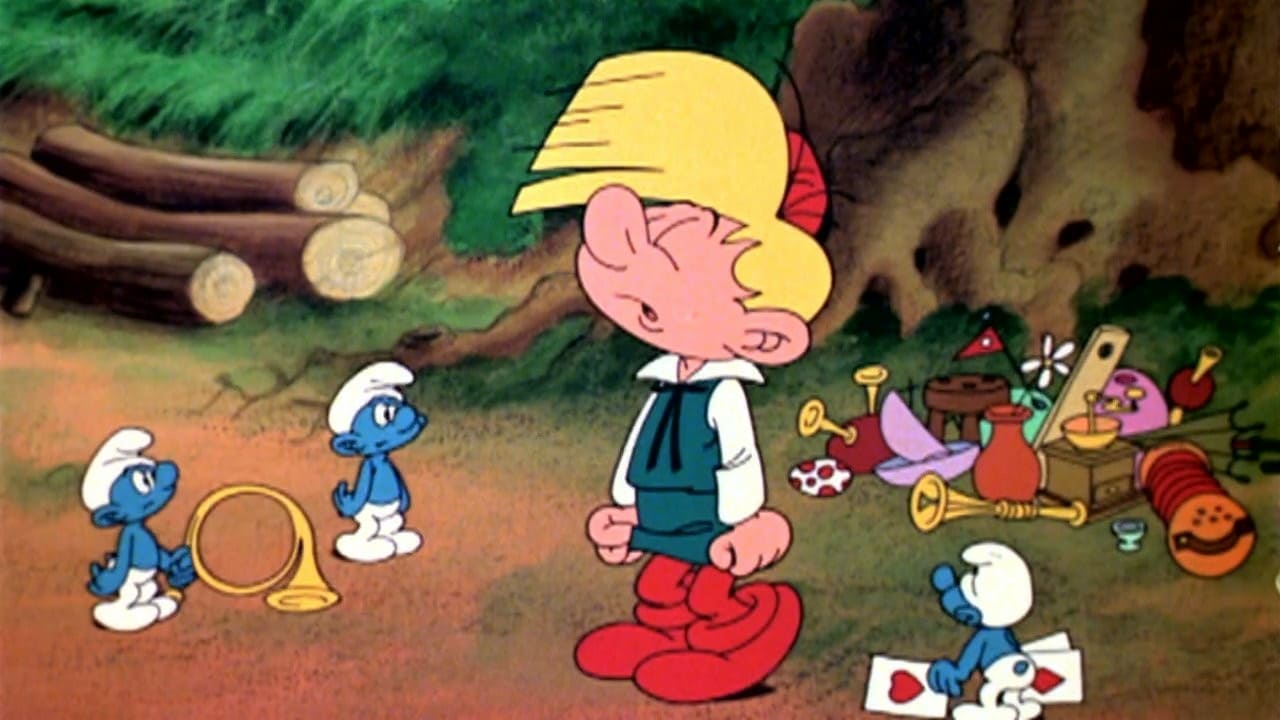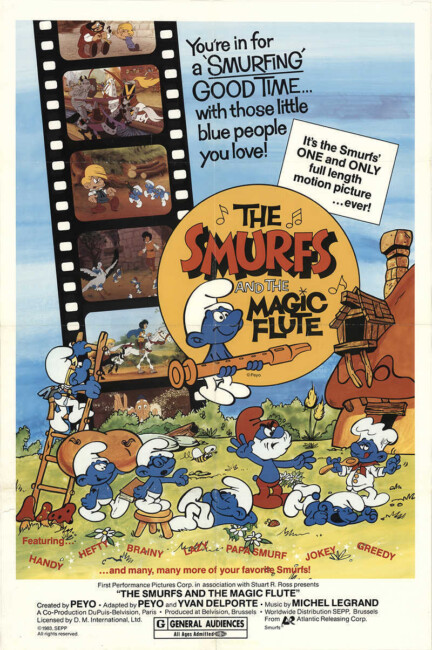(La Flute a Six Schtroumpfs)
Belgium/France. 1976.
Crew
Director/Screenplay – John Rust, Story/Songs – Yvan Delporte & Peyo, Producer – Jose Dutillieu, Music – Michel Legrand, Additional Music/Songs (English Language Version) – John Rust & John Lick, Animation Supervisor – Eddie Lateste, Art Direction – Paulette Meloul. Production Company – Editions Dupuis/Belvision France/Belvision Brussels
Voices
(English Language Version)Cast: Cam Clarke, Grant Gotschell, Patty Foley, Mike Reynolds, Ted Lehman, Bill Capizzi, Star X. Phifer, Ron Gans, Dudley Knight, John Rust, Richard Miller, David Page, Durga McBroom, Michael Sorich, Robert Axelrod)
Plot
A merchant comes to the kingdom selling musical instruments. The king and his son Johann drive the merchant out so as to prevent the court jester Pee Wee from afflicting any more of his awful singing on them. However, the salesman unwittingly leaves a flute behind. This is picked up by Pee Wee who finds that the flute is magical and has the ability to make people dance uncontrollably. This is at first an item of mischievous amusement for him. The villainous Matthew McCreep then steals the flute and uses it to rob people while they are dancing. Pee Wee and Johann seek the help of a wizard. He uses hypno-kinesis to transport Pee Wee and Johann into the land of the six-inch tall, blue-skinned Smurfs who originally made the flute. There they seek to obtain the Smurfs’ help in stopping McCreep.
The Smurfs were one of the great pop culture phenomena of the 1980s. The Smurfs were created in 1958 by the Belgian cartoonist Pierre Culliford who worked under the name Peyo. Originally known as Les Schtroumpfs, The Smurfs appeared in a strip known as Johan et Pirlouit/Johan and Peewit, which ran from 1952 to 1967 in the children’s comic-book Le Journal de Spirou. Johan and Peewit was focused around the adventures of the king’s page Johan and the court jester Peewit. In the story La Flute a Six Trous (The Flute with Six Holes) – the same story that forms the basis of the film here – the two discover a magic flute and must venture into the land of the blue-skinned Schtroumpfs/Smurfs. The Smurfs proved so popular that their adventures soon came to dominate the comic-book, before they were given their own title in 1959. The popularity of the Smurfs comics spread to reprints in other languages, as well as numerous spinoff merchandising, including a variety of records, videogames and collectible figurines.
There was a Belgian-made animated film The Adventures of the Smurfs (1965) but this has never been widely seen and does not appear to exist in English translation. Far more popular was this film (which peculiarly translates literally as The Flute to/with Six Smurfs), which was originally released to European countries in 1976 but not seen on English-speaking shores until at least 1980-1 and not released in the US until 1983. Peyo oversaw production and even contributed some of the songs.
Of course, between the point that Smurfs and the Magic Flute was originally made and its release onto English-speaking shores, the Smurfs had become a worldwide phenomenon due to the The Smurfs (1981-90), the English-language animated tv series produced by Hanna-Barbera. Indeed, the Smurfs so permeated popular culture as a result of the Hanna-Barbera series that the term ‘smurf’ became used to denote someone who is particularly childish or woolly-headed.

Following the success of the Hanna-Barbera series, this film was brought up, dubbed into English and released as a Smurfs film. In being unconnected to the Hanna-Barbera works, it is missing some of the aspects that were introduced there – The Smurfs lack much in the way of individual identity, for instance, while the regular nemesis of the wizard Gargamel is not present. The familiar characters are also dubbed by different voice actors. Also, in following the original Johan and Peewit comic-strip as opposed to the Hanna-Barbera series, Johann and Peewit (renamed Pee Wee in English-language dubbing) are the principal characters and the Smurfs do not appear until after the half-hour point.
Smurfs and the Magic Flute is made with an infuriatingly insipid banality. The inane joviality of the Smurfs and their bleating voices, using the phrase ‘Smurf’ to replace every second noun and verb, can make a reviewer wonder why they chose a job like this. The songs are excruciating. Even the animation is dull and flat. The film seems to think the greatest joke in the world is having the other Smurfs hit the brainy Smurf over the head every time he opens his mouth in a polysyllabic torrent so repeats it at every opportunity. When it comes down to it, the film’s greatest moral for its child audience would appear to be one of militant anti-intellectualism.
The Smurfs were reincarnated in live-action on the big screen with The Smurfs (2011), The Smurfs 2 (2013) and the animated Smurfs: The Lost Village (2017).
Trailer here


